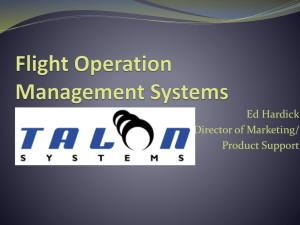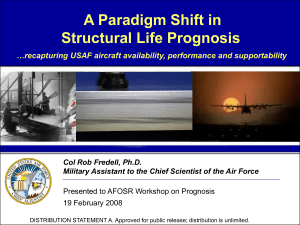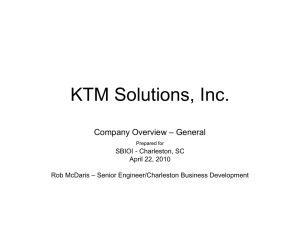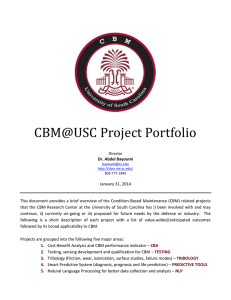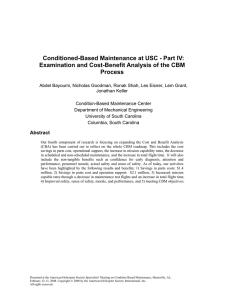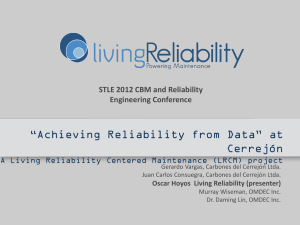CBM+SI - AIAA Info
advertisement
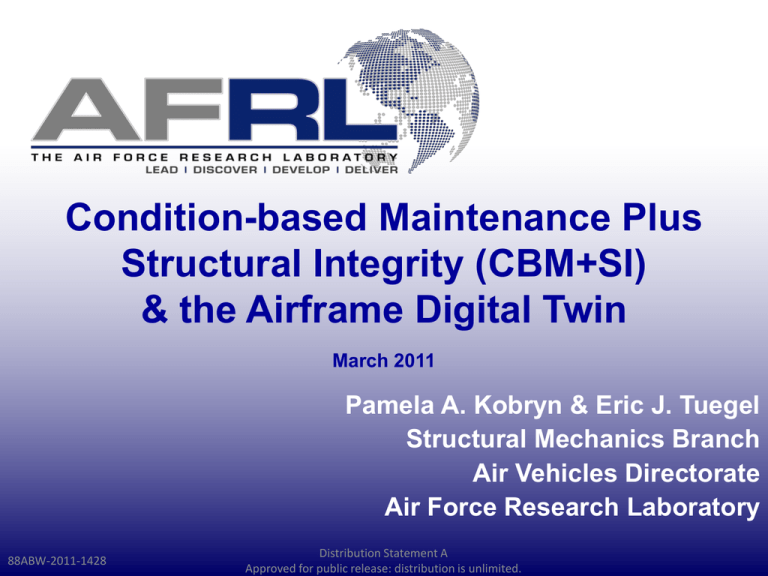
Condition-based Maintenance Plus Structural Integrity (CBM+SI) & the Airframe Digital Twin March 2011 Pamela A. Kobryn & Eric J. Tuegel Structural Mechanics Branch Air Vehicles Directorate Air Force Research Laboratory 88ABW-2011-1428 Distribution Statement A Approved for public release: distribution is unlimited. AFRL’s Condition-based Maintenance Plus Structural Integrity Initiative (CBM+SI) 88ABW-2011-1428 Distribution Statement A Approved for public release: distribution is unlimited. 2 CBM+SI Technology Focus Areas Damage State Awareness 2. Structural Health Monitoring Usage 3. Structural Teardown Assessment 4. Loads & Environment Characterization 1.E+00 6. Prognostics & Risk Analysis 9. Replacement Concepts 1.E-01 1.E-02 Single Flight Probability of Failure 1. Non-Destructive Inspection/ Evaluation 1.E-03 1.E-04 1.E-05 1.E-06 1.E-07 1.E-08 1.E-09 1.E-10 1.E-11 1.E-12 1.E-13 1.E-14 0 Legend: 88ABW-2011-1428 Emphasis Area 4000 6000 Flight Hours 7. Life Enhancement Concepts Structural Modifications 2000 8. Repair Concepts 8000 10000 12000 5. Characterization, Modeling & Testing Structural Analysis Technology Focus Area Distribution Statement A Approved for public release: distribution is unlimited. 3 CBM+SI Mid-term Vision per AFRL Air Vehicles Directorate’s “Vision 2009” • In ten years, aircraft lifecycle management and maintenance practices will be completely transformed from an inefficient, inconsistent, disparate, and labor-intensive state to an efficient, standardized, integrated, and semi-autonomous state. • The structural capability of individual airframes will be known and predictable based on the capability to characterize the current health status, predict the future health status, and plan usage and maintenance accordingly. • Risk of structural failure will be quantified and safety will be enhanced. • The inspection and repair burden will be diminished and cycle times for inspections, repairs, and modifications will be greatly reduced. • The remaining useful life of airframes will be extended. • As a result of all of these improvements, aircraft availability will be increased and O&S costs will be reduced. 88ABW-2011-1428 Distribution Statement A Approved for public release: distribution is unlimited. 4 CBM+SI Far-term Vision per AFRL CBM+SI Workshop - Feb 2009 “Digital Twin”: Real-Time, High-Fidelity Operational Decisions for Individual Aircraft Enabled by Tail Number Health Awareness • When physical aircraft is delivered, a Digital Model of the aircraft – specific to that tail number, including deviations from the nominal design – will be delivered as well. • The Digital Model will be flown virtually through the same flight profiles as recorded for the actual aircraft by its on-board SHM system. • The modeling results will be compared to sensor readings recorded by the SHM system at critical locations to update / calibrate / validate the model. • As unanticipated damage is found, it will be added to the Digital Model so that the model continually reflects the current state of the actual aircraft. • Prognostics for the airframe will be developed by “flying” the Digital Model through possible future missions. • The Digital Model will be used to determine when & where structural damage is likely to occur, and when to perform maintenance. 88ABW-2011-1428 Distribution Statement A Approved for public release: distribution is unlimited. 5 Digital Model Functions Damage from Inspections & SHM USAGE , , T, environment Structural Response Damage Progression PROGNOSIS properties, geometry FORECAST 88ABW-2011-1428 Repairs, Modifications, Replacements Distribution Statement A Approved for public release: distribution is unlimited. 6 Tech Disciplines & Challenges • Disciplines • Challenges – Aerodynamics – Structures – Materials and Manufacturing – Computer Science – Information Management AFRL POC: Dr. Eric Tuegel, eric.tuegel@wpafb.af.mil Upcoming Cross-organization Discussion Opportunities: AIAA SDM, AA&S2011, ICAF2011, ISHM Conference… 88ABW-2011-1428 – Developing parameterized, multi-disciplinary computational models of appropriate fidelity for the full-scale aircraft – Developing high-fidelity computational models of the relevant capability-controlling phenomena at physically appropriate length and time scales – Linking computational models across length/time scales at varying levels of fidelity – Understanding and incorporating all influential sources of uncertainty and variability into the models at each length/time scale – Developing analysis techniques for assessing and optimizing both capability and reliability of the aircraft – Integrating materials and manufacturing phenomena into the aircraft-level digital twin framework – Developing technologies and methods to track and update the state and behavior of both the actual aircraft and the digital twin based on real-world experience Distribution Statement A Approved for public release: distribution is unlimited. 7




